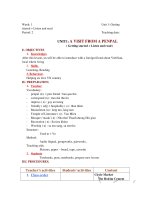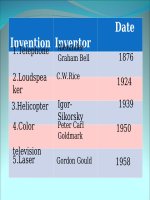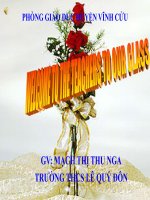date of preparation week 4 unit 02 clothing lesson 1 getting started listen and read lesson 2 speak lesson 3 listen lesson 4 read lesson 5 write lesson 6 language focus
Bạn đang xem bản rút gọn của tài liệu. Xem và tải ngay bản đầy đủ của tài liệu tại đây (557.83 KB, 21 trang )
<span class='text_page_counter'>(1)</span><div class='page_container' data-page=1>
unit :02
<b>CLOTHING</b>
Lesson 1:getting started +listen and read
Lesson 2:speak
Lesson 3:listen
Lesson 4:read
Lesson 5:write
Lesson 6:language focus
***********************************
Date of preparation : Week: 4
Date of teaching: Period 07
unit :02
<b>CLOTHING</b>
.
<i>Getting started &Listen and read</i>
I.OBJECTIVES :By the end of the lesson , students will be able to know more about
AoDai,the traditional dress of Vietnamese women.
II.LANGUAGE CONTENTS :
- Grammar: present perfect tense and passive voice .
- Vocabulary : poet, long silk tunic, slit, inspiration, Ethnic minorities, pattern …..
-Skills: S_L_R_W
III.TECHING METHOD : The communicative approach
IV.TEACHING AIDS: extraboard, pictures, tape………..
V.TIME: 45’
VI.PROCEDURES
TIME
TEACHING PROCEDURES TEACHER’S & STSACTIVITIES
: <b>1.Warm up<sub>I.</sub><sub>Getting started</sub><sub> : </sub></b>
<i><b>*Look at the dress these people are </b></i>
<i><b>wearing.*New words:</b></i>
-aKimono :áo Kimono
-a Sari :áo quấn quanh người thay quần áo
-a Veil :mạng che mặt / khăn lúp.
-a Kilt :váy của người miền núi
<b> Decide where each person comes from : </b>
a b
T:When you go abroad, every one see
you and know you come from Viet
Nam.Do you know why they know?
-Today we’ll learn about thetraditional
costumes of some countries.First,you
look at the dress that some people are
wearing. Decide where each
person comes from “
T:ask Ss to look at the clothes people
are wearing and answer where each
person comes from.
T:Where does the woman in picture a
come from ?
Ss:She comes from Japan.
</div>
<span class='text_page_counter'>(2)</span><div class='page_container' data-page=2>
c d e f
<i>*Answer keys :</i>
a.She comes from Japan.She is wearing a
Kimono.
b.She comes from Viet Nam.She is wearing Ao
dai.
c.He comes from Scotland.He is wearing a kilt.
d.She comes from India.She is wearing a sari
e.He comes from the USA.He is wearing the
Cowboy.
<b>2.Presentation:</b>
<b>II</b>.<b>Listen and read</b>:
1. Vocabulary:
-a poet: (Nguyen Du,To Huu … are poets):
nhà thơ
-a long silk tunic:áo lụa dài,rộng
-(to) slit :(to make a long thin cut in
something) :xeû
-inpriration(unc):nguồn cảm hứng
-(to) take inspiration from something:
-ethnic minorities:(Thai,Muong,Ede are
……..)dân tộc thiểu số
*Check: ROR
2.Set a scene:As you know, Ao dai is the
traditionaldress of Vietnamese women.So what
do you know about Ao dai?”Today, you’ll read a
passage and know more about it.
3.T / F Prediction : (Poster)
<b>a.The ao dai is the traditional dress of only</b>
Vietnamese women.
b.Some Vietnamese women today prefer to wear
modern clothing at work.
c.Now fashion designers want to change the
<i><b>traditional ao dai.</b></i>
<b>d.Nowadays, Ao dai is both traditional and</b>
fashionable.
<b>Q Answer Keys :</b>
a. F c.T
b. F d.T
<b>3.Practice:</b>
<b>a.Read and complete the sentences :</b>
<i>1.for a long time the ao dai has been the</i>
<i>subject of poems, novels and songs.</i>
<i>2.The ao dai is described as a long silk tunic</i>
<i><b>with slits up the sides worn over loose pants.</b></i>
3.The majority of Vietnamese women prefer
<i>towear modern clothing at work.</i>
<i>4.Some designers have modernized the ao</i>
<i>dai by printing lines of poetry on it.</i>
Ss: Because she is wearing a Kimono.
T:ask Ss to look at the clothes people
are wearing and answer where each
person comes from.
T:introduce the lesson.
T:introduce some new words on board
-example
-translation
-explanation
-translation.
-translation.
-example
-translation.
T:Lookat the poster.How many sentences
are there? Guess which sentences are true
and which are false.
T:share Ss sheets of paper of
open-prediction and guide them to do the
task.
Ss:work in invididual:read the passage
and complete the sentences and share
with their partners.
</div>
<span class='text_page_counter'>(3)</span><div class='page_container' data-page=3>
<i>5.Another alternatives is to add symbols</i>
<i>such as suns, stars, crosses and stripes.</i>
<b>b.Answer the questions :</b>
<i><b>*Answer keys :</b></i>
1.Traditionally, men and women used to
<i>wear the ao dai.</i>
2.Because it is more convenient.
3.They have printed lines of poetry on it or
have added symbols such as suns, stars,
<i>crosses and stripes to the ao dai.</i>
<b>4.Production:</b>
<b>*Discussion :</b>
a.Do you like wearing Ao dai?
b.Which do you like best? tradional AoDai
or fashional AoDai ?
c.What color is popular with students at high
school? with the middle age?
Ss:work in groups :
T:feedback and correct the mistakes.
VII.Homework :
-Prepare:”SPEAK”+LISTEN
+Identify some kinds of clothes in the pictures.
VIII.Remarks
………..
………
…..
</div>
<span class='text_page_counter'>(4)</span><div class='page_container' data-page=4>
Date of preparation: Week: 4
Date of teaching: Period 08.
unit :02
<b>CLOTHING</b>
<i><b>SPEAK</b></i>
I.OBJECTIVES :By the end of the lesson , students will be able to ask and respond to
questions on personal references about favorite ,casual and uniform clothes.
II.LANGUAGE CONTENTS :
- Grammar:present simple tense.
- Vocabulary: about clothes.
-Skills: R-L-S-W
III.TECHING METHOD :
The communicative approach
IV.TEACHING AIDS: lesson plan ,pictures,………
V.TIME: 45’
VI.PROCEDURES :
TIME
TEACHING PROCEDURES TEACHER’s & STS’ ACTIVITIES
1.Warm up :
<b>*Play a game : </b><i>NOUGHTS AND CROSSES</i>
poets traditiona
l designers
wear special convenien
t
use take pants
<i><b>*Pre-speaking:</b></i>
<b>*Vocabualry :</b>
-a suit : bộ y phục
-sleeveless (a): không cổ tay / ngắn tay.
-plain( a): trơn
-plaid ( a):kẻ ô,sọc
-(to)fade : bạc màu,phai màu
-baggy (a): rộng thùng thình
-a sweater : áo len
<i><b>*Set a scene :</b></i>
<i><b>*Match the phrases to the pictures:</b></i>
Ss:work in 2 teams:noughts and crosses
-each team choose a word and make
acorrect sentence with that word.
-which team choose and make 3
correct sentences will win the
game.
T:ask Ss to look at page 14 in book
and says” In the last lesson,we got
some information about Ao dai- the
traditional dress of Viet Nam. Today
we will learn about the casual
clothes that we wear today”
T:use some kinds of clothes to
introduce newwords.
Ss:take notes and practice the
newwords in chorus /individual .
T:ask Ss to look at the picture and
work in pairs to match the picture
and words given.
T:point to the clothes above and ask:
-Do you have one of these clothes ?
-Which clothes do you have ?
-When do you wear them ?
-What is your favorite type of clothing ?
Why ?
-Is it comfortable ?
a
,
b c
</div>
<span class='text_page_counter'>(5)</span><div class='page_container' data-page=5>
:
<b>Keys </b><i>: A-1 B-5 C-6 </i>
<i>D-3 E-8 </i>
<i> F-4 G-7 H-2 </i>
<i>I-9</i>
<i><b>*While- speaking:</b></i>
<i><b>*Survey: The form of the survey may look like this</b></i> :
<b>Questions</b> <b>Name</b> <b>Items of<sub>clothes</sub></b> <b>Notes</b>
1.what do you usually
wear on the weekend?
2.Why do you wear
theseclothes?
3.What is your favorite
type of clothing? Why?
4.Is it corfortableto
weart uniform?
5.What color is it?
6.What type of clothing
do you usually wear on
the Tet holiday?
7.What would you wear
to a party?
*<b>Report the results of the surveys:</b>
-Give the model to report the result of their
survey : S +said ………
<i><b>*Post-speaking:</b></i>
<b>*Look at these people and describe what clothes </b>
<b> they are wearing :</b>
a. b. c. d.
-What color is it ?
T:On special occasions such as:Tet
holiday, birthday, Wedding...people
often wear new clothes.If you want
to know what they wear, what do
you ask ?
<i>-What type of clothing do you wear on </i>
<i> Tet holiday?</i>
<i>-What do you wear when you go to a</i>
<i> party?</i>
Ss:work in groups: ask Ss to work in
groups of 8.Each student read and
write two more questions for the last
section of the survey about Ss’s
wear.
-Take your form to interview your
friends in your groups.Ask your
friends and tick in column “name”,
then write some notes in your form.
T:ask Ss to report the result of their
survey before the class.
Ss:the monitor of each group report
his / her result of the survey :
Ss:speak like this:
T:feedback and correct the mistakes.
Ss:look at and write to describe the
people in the pictures what clothes
they are wearing.
<i>.</i>
g h <sub>i</sub>
<b>Pictures </b> <b> Phrases </b>
A
B.
C.
D
E
F
G
H
I
1. a colorful-S-shirt
2. a plaid skirt
3. a plain Suit
4.a short –sleeved
blouse
5.a sleeveless
sweater
6.a striped shirt
7.baggy pants
8.faded jeans
9.blue shorts
Three people
said they like
their uniform
Chi said
she loved
baggy
</div>
<span class='text_page_counter'>(6)</span><div class='page_container' data-page=6>
*Three people in my group said they liked their
uniform
* …...usually wear …….on the
weekend
* ……….said he/ she loved red/baggy
pants / shirt
<i>a.He is wearing baggy pants.</i>
<i>b.She is wearing a plain skirt.</i>
<i>c.They are wearing striped shirt</i>
<i>d.He is wearing a colorful T-shirt</i>
VII.Homework
-Learn the new words by heart.
-Practice the dialogue with your partners.
-Prepare:”LISTEN”
+Identify names of clothes in the pictures.
VIII.Remarks
……….
………
Date of preparation: Week: 5
Date of teaching: Period 9
</div>
<span class='text_page_counter'>(7)</span><div class='page_container' data-page=7>
I.OBJECTIVES :By the end of the lesson , students will be able to listen for specific
information about a public anouncement about a lost little girl.
II.LANGUAGE CONTENTS :
- Grammar: simple present tense , present continuous tense.
- Vocabulary: announcement, missing, fair, entrance…
-Skills: W_R_S_L
III.TECHING METHOD :
IV.TEACHING AIDS: lesson plan ,tape, pictures , chalk……….
V.TIME: 45’
VI.PROCEDURES :
TIME
TEACHING PROCEDURES TEACHER’s & STS’ACTIVITIES
1.Warm up
*Networks :
plaid shirt
*Possible answers :colorful shirt, plaid skirt,plain suit
short-sleeved blouse,sleeveless sweate,striped shirt
baggy pants,faded jeans,blue shorts
2*Pre-listening:
Pre-teach vocabulary :
-announcement(unc):thông báo
-missing(a): lạc
-a car fair(:an event where people or company bring
their products(cars) for you to look at or buy.): hội
chợ xe hơi
-e ntrance loái vaøo
*Check:ROR
*Set a scene :<i>You’ll listen to an anouncement about a</i>
<i>lost little girl,called Mary.Listen and check(√) the </i>
<i>letter of the correct pictures to show what Mary is </i>
<i>wearing.</i>
*Identify things in the pictures
+What are these ?
T:divide the class into 2 teams and
guide them to do the task.
Ss:work in groups: go to the board
and write names of kinds of clothes.
T:feedback and correct the mistakes.
T:introduce the lesson.
-Floral pants: the trousers have flowers :
-Polka dot skirt : váy có chấm bo
-How do you say “thơng báo”in English ?
-what is the antonym of “lost”
-explanation
-translation.
</div>
<span class='text_page_counter'>(8)</span><div class='page_container' data-page=8>
+What do you call these clothes in English?
+What is this ? ( T.points)
+What color is this?
+What color are these?
+Are these shoes or sandals ?
*Answer keys :
<i>a.A:flowerpants B:blue shorts C:red pot skirt </i>
<i>b.A:long-sleevedwhiteblouse B:short-sleeved</i>
<i> pink shirt C:short-sleeved white shirt </i>
<i>c.A:sandals B:boots C:brown shoes with</i>
<i> flowers</i>
3*While- listening
*Answer keys:
a.B : She is wearing blue shorts
b.A: She is wearing a long- sleeved white blouse
c.C : She is wearing brown shoes
*Answer the questions :
a.How old is Mary ?
b.Where was she last seen 20 minutes ago ?
c.What is she look like ?
d.What is she wearing ?
a.She is 3 years old.
b.She was last seen 20 minutes ago near the
main entrance to the Car Fair.
c.She has short and dark hair.
d.She is wearing a long- sleeved white blouse
and brown shoes.
4*Post-listening:
<b>*Put the clothes in the right sections:</b>
-a blouse - a dress
-swimming trunks - a shirt
-slippers - a handkerchief
-a cap - gloves
-sandals - a tie
-boots - a skirt
<i>*Notes:</i>
-swimming trunks:quần tắm / bơi của nam
-slippers :dép lê
-footwear: giầy dép
-accessories : đồ phụ tùng / đồ khẩu trang …
<i><b>* Answer keys :</b></i>
<i>Women’ s</i>
<i>clothes</i>
<i>Men’s</i>
<i>clothes</i> <i>Footwear</i> <i>Accessories</i>
a blouse
a dress
a skirt
a shirt
a tie
swimmin
g trunks
sandals
slippers
boots
a cap
handkerchief
pictures.
T:elicit Ss by asking them some
questions
Ss:listen the tape once and check the
letter and compare the keys with
partners.
T:give feedback.
Ss:work in pairs:ask and answer the
questions about information in
announcement.
Ss:work in agroups:read the words
given and put them in their correct
items in the table.
T:give feedback.
VII.Homework :
VII.Remarks
-Learn the new words by heart.
-Finish all exercises into your
notebooks.
</div>
<span class='text_page_counter'>(9)</span><div class='page_container' data-page=9>
………
……….
Date of preparation: Week: 5
Date of teaching: Period 10.
unit
:02<b>CLOTHING</b>
<i><b>Read</b></i>
</div>
<span class='text_page_counter'>(10)</span><div class='page_container' data-page=10>
II.LANGUAGE CONTENTS :
- Grammar: simple present tense.
- Vocabulary: material, cotton, wear out, style, be out of fashion ….
-Skills: W-S_R_L
III.TECHING METHOD : The communitive approach
IV.TEACHING AIDS: lesson plan, pictures ,chalk……….
V.TIME: 45’
VI.PROCEDURES :
TIME TEACHING PROCEDURES TEACHER’S&STS’ACTIVITIES
1.Warm up :
*Chatting :
-What do you often wear in the summer ?
-What color do you like best ?
-What is your favorite type of clothes ?
-Do you like wearing school uniforms ?
-What would you like to wear to a party ?
2*Pre-reading:
*Pre-teach vocabulary :
- material(unc):vải , chất liệu
-cotton(unc):bông , sợi
-(to) wear out:(use stb so much that it no longer
works or can no longer used. ): moøn , rách
-a style:lọai
-be out of fashion :lỗi thời
*Check vocab: ROR
*Set a scene :
<b>3*While-reading:</b>
<i><b>*Fill in the missing date and words :</b></i>
<b>1.18th<sub> century: workers liked to wear jeans cloth</sub></b>
<b> because the material made from cotton was </b>
very strong and could hardly wear out.
<b>2.1960s:A lot of university and college students </b>
wore jeans
<b>3.1970s: Jeans became cheaper so many people </b>
began
wearing jeans.
<b>4.1980s : Jeans became high fashion clothing</b>
<b>5.1990s: The sale of jeans stopped going up</b>
<i><b>*Ask and answer the questions :</b></i>
1.The words “Jeans” comes from a kind of
material that was made in Europe.
2.The 1960s’ fashion were embroidered jeans
,painted jeans and so on
T:ask Ss some questions
Ss:listen and answer the questions
one by one .
-translation
-realias
-explanation
-translation
-translation
T:stick a picture and ask Ss :
-Are they students ?
-What kind of trousers are they
wearing?
-Do you know when jeans appeared
for the first time ? and where ?
ÞToday,we’ll read a passage about
the origin of Jeans.
T:Now,answer the question:
<i>-What do you want to know about jeans? </i>
<i>-Who first designed jeans ?</i>
<i>-Why do young people like wearing jeans?</i>
<i>-Are jeans more expensive than baggy</i>
<i>pants?</i>
<i>-Are jeans fashionable in VN ? Why ?</i>
T:share Ss handouts and guide them
to do the task.
Ss:work in groups:read the passage
and complete the sentences with
information in the passage.
T:give feedback.
</div>
<span class='text_page_counter'>(11)</span><div class='page_container' data-page=11>
3.Because jeans became cheaper.
3.Jeans at last became high fashion clothing
in the 1980s
5.The sale of jeans stopped growing because
worldwide economic situation got worse in
the1990s
<b> </b>
<b>4*Post- reading:</b>
<i>*Tell some kinds of jeans you know :</i>
<i>*Do you think jeans are in fashion ?</i>
T:feedback and correct the
mistakes.
Ss:work in groups :think of kinds of
<i>jeans :tight / flared jeans, baggy</i>
<i> jeans,faded jeans, ripped </i>
<i>jeans,stone- washed jeans.</i>
Þ<i><b>What type of jeans do you like</b></i>
<i><b> wearing ?</b></i>
Ss:work in groups:discuss
about :”doyou think jeans are
fashionable ?”
VII.Homework :
-Learn the new words by heart.
-Finish all exercises into your exercisebooks.
-Prepare:”WRITE”
VIII .Remarks
………
………..
Date of preparation: Week: 6
Date of teaching: Period 11.
unit
:02<b> CLOTHING</b>
<i><b>write</b></i>
I.OBJECTIVES :By the end of the lesson , students will be able to write an
</div>
<span class='text_page_counter'>(12)</span><div class='page_container' data-page=12>
II.LANGUAGE CONTENTS :
- Grammar: simple present tense / connectors (firstly,secondly ….. )
- Vocabulary: encourage ,be proud of , be equal in , bear one’s name, self-confident.
-Skills: W_R_L_S
III.TECHING METHOD : The communicative approach
IV.TEACHING AIDS: lesson plan, colored chalk…………
V.TIME: 45’
VI.PROCEDURES :
TIME
TEACHING PROCEDURES TEACHER’S &
STS’ACTIVITIES
1.Warm up :
Chatting :
-What do you think about your uniforms?
-How often do you wear uniforms?
-How do you feel when wearing uniforms?
-If you have a choice, what type of clothing do
you want to wear when going to school?Why?
<b>2*Pre-writing:</b>
*Vocabulary:
<i>(-to) encourage :khuyến khích</i>
-be equal in : (Tuan gets 9 marks.Hung gets 9
<i>marks,too.So They are equal in marks.):công bằng</i>
-(to) bear one’s name:mang teân
.
-freedom of choice(unc):tự do lựa chọn
-self-confident(a)tự tin
<i>*An argument :</i>
Organization Language
Introduction
Lets the readers
know the writer’s
point of view
My opinion is
………..
I think ……
Series of
arguments
Presents
arguments in a
logical way(one
in each
paragraph),gives
examples where
possible
Firstly ……
Secondly …..
Finally …….
Conclusion Sumps up the <sub>argument</sub> Therefore, ….<sub>In conclusion,…..</sub>
<b>*Comprehension Questions :</b>
+What do you write in “introduction”?
What language is used?
+How can we present series of arguments?
What language is used?
+What do you write in conclusion?
What language is used ?
<b>3*While-writing:</b>
a.Read the topic and Outline A.Then read the
passage
b.Now write a paragraph of 100-150 words :
*Questions :
T:ask Ss some questions about
wearing uniform.
Ss:listen and answer the questions
one by one.
-translation
-situation
-translation
-translation
-translation
T:in speaking,you often make arguments
with each other to protect your ideas
and refuse others. In writing, there is a
argumentative writing which presents
one’s ideas, opinions and make them
persuasive to readers. At the same time ,
this kind of writing has to successfully
protect its opinion and refute the opposite
ones. First you should understand clearly
the structure of the an argumentative
writing . it should have three parts as in
the text book”
T:ask Ss to answer the questions to
check their understanding.
Ss:answer the questions about the
arguments.
-What is the topic of the passage?
-Why does wearing uniforms encourage
Ss to be proud of their school?(Because
the uniforms bear their school’s name)
-How do Ss feel when wearing uniforms?
(They feel equal in many ways)
-Do Ss have to think of what to wear
every day? ( No )
</div>
<span class='text_page_counter'>(13)</span><div class='page_container' data-page=13>
<i>+What is the topic of the argument?</i>
<i>+Why should secondary Ss wear</i>
<i> casual clothes ?</i>
*<i><b>Possible answer</b></i> :
In my opinion, secondary school students should wear
casual clothes.
Firstly, casual clothes make students feel comfortable.
Secondly, wearing casual clothes gives students
freedom choice. They have rights to choose sizes,
colors and fashion that they love.
Thirdly, casual clothes makes students feel self-
confident when they are in their favorite clothes.
Finally, casual clothes make school more colorful and
lovely.
In conclusion, secondary school students should wear
casual clothes. Wearing casual clothes is convenient,
comfortable and fun.
<b>4*Post- writing: correction</b>
<i><b> CLASSIFICTION</b></i>
equal, comfortable, self -confident, proud,
practical, colorful, uniform, casual clothes,
lively
<b> For</b> <b> Against</b>
proud
equal
practice
uniform
comfortable
self -confident
colorful
casual clothing
lively
T:say “ you have read an argument the
supports the idea the secondary school
should wear uniforms. Now use the
Outline B as the guidelines, write a
paragraph that supports the argument
that secondary students should wear
casual clothes.”
Ss:work in individual: use outline B to write a
paragraph and share with their partners to
compare.
T:feedback and correct the mistakes.
T gives a lot of words which
depend on two opinions “ for” or “
against” with wearing uniform
clothes.
Ss:work in groups.
VII.Homework :
-Learn the new words by heart.
-Finish all exercises into your exercisebooks.
-Prepare:”Language focus”
+Find out new words.
+present perfect tense with:for / since /already / yet
+passive voice.
VIII.Remarks
………
……….
Date of preparation: Week: 6
Date of teaching: Period 12
Unit :02
<b> CLOTHING</b>
<i>. LANGUAGE FOCUS</i>
</div>
<span class='text_page_counter'>(14)</span><div class='page_container' data-page=14>
II.LANGUAGE CONTENTS :
- Grammar: + present perfect tense
+ passive voice.
- Vocabulary: Reunification Palace - vegetarian.
-Skills: W_R_L_S
III.TECHING METHOD : The communicative approach
IV.TEACHING AIDS: lesson plan, colored chalk., pictures…
V.TIME : 45’
VI.PROCEDURES :
TIME
TEACHING PROCEDURES TEACHER’S & STS’ACTIVITIES
1.Warm up :
<b>*Pelmanism :</b>
make see build grow eat
built eaten grown seen made
<i>*Keys :-make → made</i>
<i> -see → seen</i>
<i> -build → built</i>
<i> -grow → grown</i>
<i> -eat → eaten </i>
2.Practice :
*Activity 1:
<b>I. Present Perfect with since / for :</b>
1.Work with a partner.Read the dialogue :
<i> *Form : S + have / has + past participle</i>
*Usage:express an action which started in the
past and continue up to the present.
<b> +since : a point of time; answering :When ?</b>
<b> +for : a duration of time ; answering :How </b>
long ?
T:ask Ss :How long have you learnt E ?
<i>Ss:We have learnt E since 2007</i>
<i> We have learnt E for 3 years.</i>
*Make the sentences :
a.They / do the test / 15 minutes .
b.He / be / Hanoi / 1997
c.I / not see / him / a long time.
d.They / play soccer / 3 o’clock
·Now use the information in the table to make
<i> similar dialogue :</i>
<b>*Suggested dialogues :</b>
S1 : Come and see my photo album.
S2 : Lovely! Who’s this boy ?
S1 :Ah! It’s Quang, my brother’s friend.
S2 : How long have you known him ?
S1 :I’ve known him for seven months ?
S2 : Have you seen him recently ?
S1 : No, I haven’t seen him since January.
a.Lan-old friend six years 2003
b.Quang-brother’s
friend
seven months January
c.Hoa-new friend three weeks Monday
T:prepare 10 cards with numbers on
one side and to-infinitives and their
past participle on the other.
-make sure the infinitives and their
past participle are mixed up.
Ss:work in 2 teams:turn over the cards
<i> and see if they match (see → seen)</i>
-continue until all the cards are turned
over.
Ss:work in pairs:practice the dialogue
with their partners.
T:ask Ss:what tense we use in the dialogue ?
-When do we use the present perfect?
<b> -When do we use for and since ?</b>
Ss:work in individual:use cueswords to
make sentences.
Ss:work in pairs:use information in the
table to make the similar dialogues:
T:introduce the lesson.
T:stick sub-board and present information in
the table with words.
Ss:take notes and practice .
Ss:work in pairs:read the dialogue with their
partners.
</div>
<span class='text_page_counter'>(15)</span><div class='page_container' data-page=15>
*Activity 2:
<b>II. Present Perfect with already / yet :</b>
2.Imagine you and your friend are visiting
HCM city.Look at the notes on page 20, there
are things you have done, and some things you
haven’t done, what are they ?
*Elicit from Ss :
I have seen Giac Lam Pagoda.
I have eaten Chinese and french food.
I haven’t seen Reunification Palace, Zoo and
Botanical Garden, I haven’t tried Vietnam
vegetarian.
<b>* New words :</b>
- Reunification Palace : dinh thống nhất
- Pagoda = temple : chùa
- Zoo and Botanical Gardens : thảo cầm
viên
- Vegetarian : đồ chay
<b> *Read the dialogue :</b>
<b>S1 : Have you seen Giac Lam Pagoda yet ?</b>
<b>S2 : Yes, I’ve already seen it.</b>
<b>S1 : Have you eaten Vietnamese food yet ?</b>
S2 : No, I haven’t.
<i><b>*Notes: Elicit the use and the position of </b></i>
<i>“already’ and “Yet” in the sentence</i>
<i>*”Already” is used in affirmative sentences.</i>
<i>* “Yet” is used in the negative sentences </i>
<i> and question (end of the sentence). </i>
-<i><b> Have / has +S + PP ... yet ?</b></i>
-<i><b> S+ have / has already +PP ...</b></i>
*Work with your partners :
*Activity 3 :
<b>III. Present Perfect with ever :</b>
1.Read the dialogue :
<i><b>A: Have you ever read a comic?</b></i>
B:Yes, I have.
A: When did you last read one?
B:This morning.
<i><b>* The past simple to talk about definite time.</b></i>
<i>* The present perfect to talk about indefinite </i>
<i>time.“ever”: is used in a question .</i>
2.Work in a partner.Ask and answer questions
about each of the items in the box :
*Example :
<i>Tom: Have you ever been to Singapore?</i>
<i>Mary: Yes, I have. </i>
<i>Tom: When did you go there?</i>
<i>Mary: Two years ago.</i>
*Activity 4 :
<b>IV.Passive voice :</b>
<i>1.Form :</i>
Present ferfect : Have / has + been + P.P
Present simple : is / are / am + P.P
Past simple : was / were + P.P
Simple future : will + be + P. P
<b>2.Read the first sentence and complete the </b>
make the dialogues as above.
T:feedback and correct the mistakes.
Ss:work in pairs:
<i><b>-What does “ever” mean ?</b></i>
<i><b>-When do we use “ever” ?</b></i>
*<i><b>Pay attention to the adverb “Ever”.</b></i>
*<i><b>Distinguish the differences </b></i>
<i><b>between </b></i>
<i><b> the simple past and present </b></i>
<i><b>perfect.</b></i>
Ss:work in pairs :use the words in the
box and make dialogues as above.
T:feedback and correct the mistakes.
T:stick sub-board on board and remind
Ss form and usage of passive voice.
Ss:take notes and memorize.
</div>
<span class='text_page_counter'>(16)</span><div class='page_container' data-page=16>
<b>second sentence with the same meaning </b>
( page 21 )
*Answer keys :
1.Jeans cloth was made completely from cotton on
the 18th<sub> century.</sub>
2.Rice is grown in tropical countries
3.Five million bottles of champagne will be
produced in France next year.
4.A new style of Jeans has just been introduced in
the USA.
5.Two department stores have been built this year.
<b>3.Change the sentences from the active into </b>
<b>the </b>
<b> passive :</b>
<b>*modal verbs: must, can, should, might, and</b>
<b>the patterns have to / be giong to </b>
<b> Þ modal verbs + be + P. P</b>
Have to / be going to + be + P.P
*Answer keys :
<i><b>a.The problem can be solved.</b></i>
<i>b. Experiment on animal should be stopped.</i>
<i>c. Life might be found on another planet.</i>
<i>d. All the schools in the city have to be </i>
<i>improved.</i>
<i>e. A new bridge is going to be built in the area.</i>
3.Consolidation
*Correct the mistakes in the following
sentences :
a.I already have finished my homework.
®I have already finished my homework.
b.A coat should been worn because it is cold
out.
®A coat should be worn because it is cold out
c.He has learnt English since 2 months.
<i> ® He has learnt English for 2 months.</i>
d.How long has the match started ? –since 3
o’clock
®When has the match started ? –since 3
<i>o’clock</i>
Ss:work in individual:use passive form
to complete the sentences.
*The passive form of modal verb and
the verb patterns <b>Have to / be going to:</b>
-Elicit from the ss the modal verbs
Ss:work in individual :do exercise 5 (on
page 21 ) in textbooks .
T:feedback and correct the mistakes.
T:share Ss handouts and guide them to
do the task.
Ss:work in individual :read the
sentences and find out the mistakes and
correct them.
VII.Homework :
- Do all these exercises in exercise book
- Use present perfect tense to make 5 sentences .
-Prepare: test 45’
VIII.Remarks
………
……….
Preparing date: ………….. Week:
Teaching date: ………… Period:
</div>
<span class='text_page_counter'>(17)</span><div class='page_container' data-page=17>
<b>I. Objectives : By the end of the lesson , sts use their knowledge to do the</b>
test
<b>II . Language contents</b>
1 Grammar : simple tenses
Wish sentences
Passive voice
Used to
2. Vocab : unit 1,2
3. Language skills : S_W_R_L
<b>III. Teaching method : the communicative approach</b>
<b>IV. Teaching aids: lesson plan, cassette, photo papers…..</b>
<b>V. Time : 45’</b>
<b>VI. Procedures</b>
Ma traän
Chủ đề <b>Nhận biết</b> Thông hiểu Vận dụng Tổng
TN TL TN TL TN TL
I. Listening 4c<sub>2ñ</sub> 4c <sub>2ñ</sub>
II.Vocb,
grammar 12c3ñ 12c3ñ
III. Reading <sub>1.5ñ</sub>6c <sub>1,5 ñ</sub>6 C
IV.Writing 6c <sub>2 ñ</sub> <sub>1,5 ñ</sub>3C <sub>3,5 ñ</sub>9C
Toång 12 C<sub>3 ñ</sub> 10 C<sub>3.5ñ</sub> <sub>3,5 ñ</sub>9 C 31C<sub>10 ñ</sub>
<b>FULL NAME : </b> <b>ENGLISH TEST</b> <b>Marks </b>
<b>CLASS : 9A</b> <b>Time allotted : 45' </b>
<b>I ) Listen to the passage about Malaysia and choose the correct information among </b>
<b>A,B,C,D. ( 2ms )</b>
1) Malaysia has an area of ……… .
A. 312.758 km2<sub>.</sub> <sub>B. 329.758 km</sub>2<sub>.</sub>
</div>
<span class='text_page_counter'>(18)</span><div class='page_container' data-page=18>
A. the dollar. B. the yen.
C. the ringgit. D. the won .
3) Malaysia had a population of ……… in 2001.
A. over 30 million. B. over 20 million.
C. over 22 million. D. over 21 million.
4) The ……….. of Malaysia is Kuala Lumpur.
A. national language . B. climate .
C. official religion D. capital city.
<b>II_ Choose the correct answer among A , B , C , D . ( 3 ms )</b>
1_ We ………..to the museum last week .
<i><b>A_ go B_ went </b></i> <i><b>C_ are going D_ were going </b></i>
2_ Nguyen Du was a famous ………in the eighteenth century .
<i><b>A _ poet </b></i> <i><b>B _ poem </b></i> <i><b>C _ poetic </b></i> <i><b>D _ poetry</b></i>
3_ She ……… in Da Lat since 1998 .
<i><b>A _ lived </b></i> <i><b>B _ lives</b></i> <i><b>C _ has lived </b></i> <i><b>D _ will live</b></i>
4_ My sister enjoys ………the guitar .
<i><b>A _ to play </b></i> <i><b>B _ playing </b></i> <i><b>C _ played D _ play</b></i>
5. I wish they ……….here now .
<i><b>A _ come</b></i> <i><b>B _ are coming </b></i> <i><b>C _ comed</b></i> <i><b>D _ came </b></i>
<i><b>6_ Kieu ……… by Nguyen Du .</b></i>
<i><b>A _ wrote </b></i> <i><b>B _ was written </b></i> <i><b>C _ written</b></i> <i><b>D _ was writed</b></i>
7. Malaysia is divided ………..two rigions.
A- to B- on C- in D- into
8. I wish they ………here tomorrow.
A- will come B- would come C- come D- came
9. …………..clothes do you prefer , T shirt or pullover.
A- What B- How C- Which D- Where
10. Mary …………..write to me last year.
A- uses to B- used to C- is used to D- was used to
11. Millions of Christmas cards………..last month
A. were sent B. sent C. send D. are sent
12. Vietnamese people are very ………..and hospitable.
A. friend B. friendless C. friendly D. friendship
<b>III_ Read the following passage and decide the statements if they are true ( T ) or </b>
<b>false ( F ) ( 1,5 ms )</b>
</div>
<span class='text_page_counter'>(19)</span><div class='page_container' data-page=19>
<i><b>1. Poets , writers and musicians have taken inspiration from the ao dai for many </b></i>
<i>centuries .</i> ………..
<i><b>2. By tradition ,both men and women used to wear the ao dai .</b></i>
. ………
<i><b>3. The design and material used for men and women are the same.</b></i>
………..
<i><b>4. Nowadays , the ao dai is often worn by women on special occasions and at work .</b></i>
<i> ……….. </i>
<i><b>5. The traditional ao dai has been changed by musicians on these days . </b></i>
………..
<i><b>6. Nowadays ,the ao dai looks modern and fashionable because it has been printed lines of</b></i>
<i>poetry on. ………</i>
<b> IV_ Put the sentences into their correct order to make a suitable paragraph . ( 2 ms )</b>
1. Finally , casual clothes make school more and lively .
2. Secondly , wearing casual clothes gives students freedom of choice . They can
choose sizes , colors , and styles of clothes that they like .
3. My opinion is that secondary school students should wear casual clothes .
4. In conclusion ,secondary school students should wear casual clothes because they
are convenient , comfortable and fun .
5. Thirdly , casual clothes make students feel self-confident .
6. Firstly , casual clothes make students feel comfortable .
………
………
………
………
………
………
………
………
………
………
……….
<b>V . Rewrite the following sentences(1,5 ms)</b>
1. I don’t have a sister.
-> I wish………..
2. They grow rice in tropical countries.
</div>
<span class='text_page_counter'>(20)</span><div class='page_container' data-page=20>
<b>ANSWER KEY</b>
I. 1. B
2. C
3. C
4. D
The national language is Bahasa Malaysia. Malaysia is one of the countries of the
ASEAN. They separated by about 640 km of the sea and together comprise an area
of 329,758 sq km . Malaysia unit of currency is the ringgit. The capital of Malaysia
is Kuala Lumpur . The population was over 22 million.
II.
1. B
2. A
3. C
4. B
5. D
6. B
7. D
8. B
9. C
10. B
11. A
12. C
III.
1. T
2. T
3. F
4. F
IV.
3-6-2-5-1-4
V.
1. I wish I had a sister.
2. Rice is grown in tropical countries.
3. write
VII.Homework
-Prepare U3 Getting started + Listen & read
VIII.Remarks
</div>
<span class='text_page_counter'>(21)</span><div class='page_container' data-page=21></div>
<!--links-->









